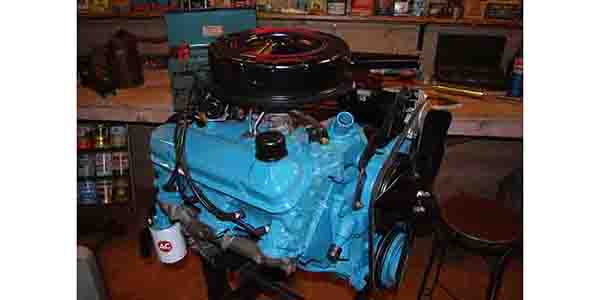The first Pontiac V8 lasted only one year. Out in 1932, it was the same 251-cid V8 used in Pontiac’s almost-dead parent make, Oakland, during 1930 and 1931. The 85-hp flathead was basically unchanged in the Pontiac, except that the mounting system was slightly modified. Pontiac had really just renamed the Oakland V8 as an upper series Pontiac because it was a pretty good way to clear out the parts bin. In 1933 and 1934, Pontiac built only eight-cylinder cars, but they used a flathead straight eight.
From 1935 until 1954, you could get a Pontiac with a flathead six or a flathead straight eight. The company was a bit slow in following other manufacturers in adopting the overhead-valve V8. It is said that 1953 and 1954 Pontiacs were set up to mount a V8, but the general manager of the GM division was killed in a car-train crash and, as a result, Pontiac’s move to a modern V8 was delayed several more years. In 1954, only Packard and Pontiac continued to offer straight eights.
In 1955, Pontiac started towards a youthful new, high-performance image that it would nurture during the last half of the ’50s. The first important change came under the hood, where a 287 cid overhead-valve V8 was nestled. When linked to a manual transmission this motor had 7.4:1 compression and 173 brake horsepower. Adding Hydra-Matic Drive upped compression to 9.0:1 and horsepower to 180.
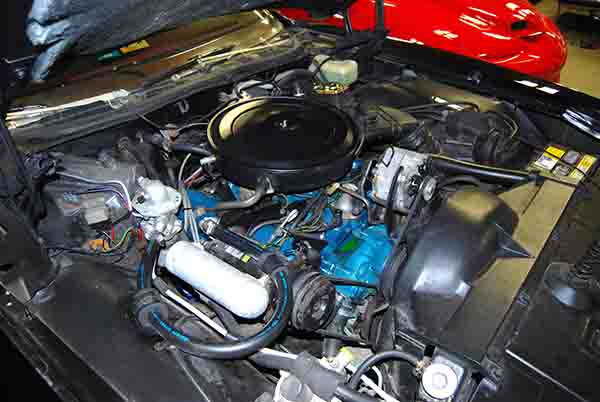
Engineers Clayton B. Leach and Ed Windeler developed this cast-iron engine with ball-and-stud rocker arms, gusher type cooling, pressure-suction crankcase ventilation, and easy-to-cast block construction to keep costs low and make it efficient. It had a very short, still crankcase, a lightweight valve train, five main bearings, hydraulic valve lifters, and a Carter WGD or Rochester 2GC two-barrel carburetor. By mid-1955, an optional “power pack” engine with a four-barrel carburetor and dual exhausts was made available.
In 1956, the 297 was bored to 317 cid. Pontiac really jumped in the horsepower race with built-for-racing “NASCAR” options carrying dual four-barrel carburetors and delivering up to 285 hp. This was just the beginning. In 1957, the stroke was increased and displacement rose to 347 cid. The original, limited-edition Pontiac Bonneville got a 315-hp fuel-injected version of the engine. There was also a 290-hp “Tri-Power” (three two-barrel carburetors) option, plus a pair of 317-hp NASCAR Tri-Power engines.
Pontiac engineers got the boring bar out again in 1958, to reach 370 cid. Fuel-injection was made an option and again there were Tri-Power and NACAR (a.k.a “Tempest 395-A) engine options delivering horsepower numbers as high as 330. In 1959, the 370 was stroked out to become the famous 389-cid Pontiac V8. Fuel-injection was gone, but the highest output level was now up to 345 hp thanks to a Tempest 395-A option with a 10.5:1 compression ratio and Tri-Power combination.
The 389-cid V8 was used in all Pontiacs in 1960. In 1961, the new Tempest compact offered a different type of V8 as a very rare option. This was a 215-cid 155-hp job built by Buick. Also showing up very late in the calendar year was a 421-cid V8 that became a regular production option (RPO) in 1962. It produced 405 hp. The 421 did not differ greatly in basic design from the 389-cid V8, but featured lighter connecting rods and much larger crankshaft journals. The 421-cid 405-hp designation became well known after it appeared on the hoods of many NASCAR stock cars and Super-Duty drag cars.
More directly derived from the 389, a new 326-cid V8 arrived in the upsized 1963 Tempest. It was a de-stroked version of the 389 with a four-barrel carburetor and 260 hp. Pontiac continued with Tri-Power options for both the 389 and 421. Two 421 H.O. V8s produced 353 and 370 hp, but the hottest options of all were the 390-, 405- and 410-hp versions of the 421 Super-Duty V8. These featured up to 13.0:1 compression and came with a single four-barrel, three two-barrel or dual four-barrel carburetors. They were intended strictly for racing and to make Pontiac the competition king.
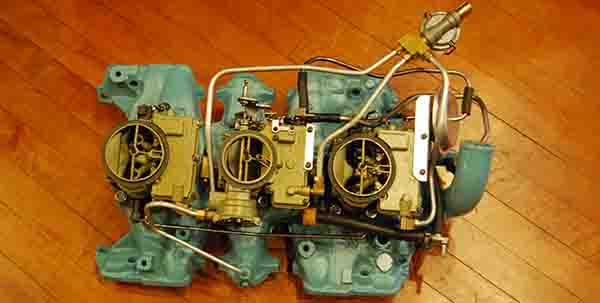
In 1964, GM management banned corporate racing involvement and Pontiac was forced to dump its Super-Duty racing program. The 421 H.O. options were allowed to remain and 370 hp was tops. The 389 was still around and the Tempest (now a mid-sized car) retained the 326, until the GTO was snuck out as an option at midyear. The first true “muscle car,” the so-called “Goat” came with a base 389-cid 325-hp V8 in a mid-sized body. An optional Tri-Power version of the same engine with 348 hp was offered. Pontiac’s intention was to use the GTO to maintain its high-performance image after the racing ban. A good job was done of this. By 1965, the Tri-Power GTO was up to 360 hp.
There were 11 different Pontiac V8 engine options for 1966, starting with the 326-cid 250-hp Tempest base V8. The four-barrel version with 10.5:1 compression upped horsepower to a healthy 285. These options were limited to Tempests. The two-barrel 256-hp version of the 389 was base engine in Catalinas. There was also a two-barrel 389 with 10.5:1 compression and 290 hp for Catalinas, Star Chiefs and Executives. The four-barrel 325-hp version was standard in Grand Prixs and optional in full-size Pontiacs. The base GTO engine was a 389 with 335 hp and a 360-hp Tri-Power version was optional. The big 421 came in 339-, 356- and 378-hp versions. The first one was standard in Catalina 2+2 performance models.
The 400-cid Pontiac V8 that bowed in 1967 Pontiacs was a bored-out version of the 389 and a new 428 was a bored-out 421. The extra cubes were added to mask the fact that Tri-Power options were no longer offered. The top 400-cid V8 was a four-barrel edition for the GTO that had the same 360-hp rating as the previous year’s 389 Tri-Power version. Likewise, the top 428 carried the same 376-hp rating as the 1966 Pontiac 421 Tri-Power motor. Also bowing in 1967 was the new Firebird, which had the 326 as its base V8. Options included the 400 and a 400 with Ram Air Induction. In 1968, both Firebirds and Tempests received a new 350-cid Pontiac V8, which was essentially a bored out 326. These were merchandised as “packages” for the Firebird.
Never seeing the light of day was Pontiac’s only really new 1969 engine, a 303-cid small-block V8 that never got too far beyond the prototype stage. It was developed strictly to make Firebirds competitive in Sports Car Club of America (SCCA) Trans-Am racing, but only about 25 cars were fitted with these short-stroke, tunnel-port V8s. For showroom customers, the 400-cid Trans Am model of the Firebird was introduced in 1969.
For 1970, a bored-and-stroked version of the Pontiac big-block V8 arrived. This 455-cid engine was not really one of the year’s high-performance options, but it had huge amounts of torque and potential for future development. Steps in this direction were made in 1971, when the Trans Am version of the Firebird got a 335-hp Ram Air version that was also optional in the LeMans GTO.
When a Chevy Nova-based compact car revived the Pontiac Ventura nameplate in 1972, a Chevrolet-built 307-cid V8 was available for under its hood. Otherwise, Pontiac stuck with the 350-, 400- and 455-cid V8s with up to 300 net horsepower (a new rating system). In 1973, the Ventura got the Pontiac 350 instead of the 307; in 1975, it got an Olds-built 260. By that time, Pontiac V8s had catalytic convertors and other power-robbing economy and emissions changes. The last year for the big 455 was 1976. In 1977, a 301-cid engine was the base V8 in many models., while the Ventura used a 305-cid V8 made by Chevrolet or GM of Canada. There was also an Oldsmobile-built 403-cid “alternate” V8 for Pontiacs sold in California.
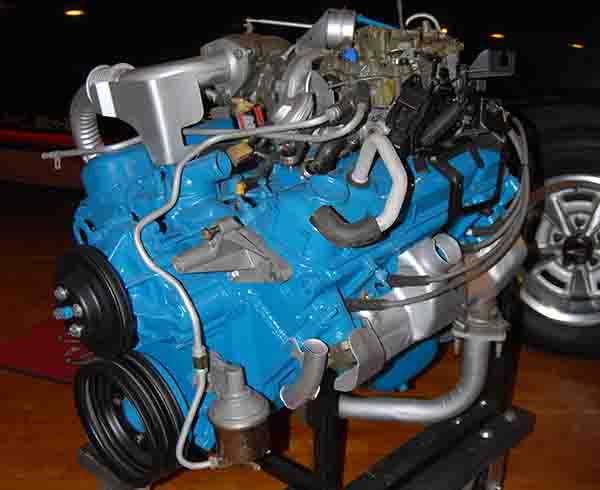
Pontiac developed a turbocharger installation for the 301. A single Garrett AiResearch TBO-305 draw-through turbo was used. It featured a nominal maximum boost of 9 psi. The 301 hadn’t been designed for this sort of application, so Pontiac engineers added a higher-capacity oil pump and somewhat beefed up the engine. So, the 301 Turbo was upgraded over the standard 301. To limit detonation and allow the use of regular unleaded gasoline, the compression ratio was lowered to 7.6:1, the Rochester Quadrajet four-barrel carburetor was modified to provide automatic under-boost enrichment and a Delco Electronic Spark unit (shared with the Buick turbo V6 and normally aspirated 1980–1981 301 four-barrel engines) was added to retard engine timing under load. A hood bulge was added to make room for the turbo.
The 301 Turbo was introduced in the 1980 model year. It eliminated Pontiac’s use of the 400 and 403 V8s. In its initial production form the Turbo V-3 was rated for 210 hp and 345 lb.-ft. of torque. With minor 1981 changes it was rated 200 hp and 340 lb.-ft. of torque. It was RPO LU8 and it could be had only with automatic transmission and a 3.08 axle and cost $350 in a Trans Am and $530 in a Formula Firebird. The turbo met federal emissions standards, but wasn’t available in cars built for the California market.
It was the 301-, 305-, 350-, 400- and 403-cid V8s for the next several years, but in 1980 all engines over 350 cubic inches were dropped and a new 265-cid V8 was optional in Firebird, LeMans, Grand Prix, Catalina and Bonneville models. This 4.3-liter V8 was built by Oldsmobile. Also new in 1980 was a 350-cid Olds-built diesel.
By 1982, Pontiac V8 options were down to a pair of 305-cid V8s for Firebirds and a single 350-cid Olds-built diesel for Grand Prixs and Bonnevilles. By 1986, the V8 lineup consisted of five 30s with 150- to 205 hp. Then, a 307-cid V8 became the standard power plant in Safari station wagons. An H.O. version of the Trans Am 305 was added in 1988, along with an even hotter 350-cid 225 hp V8 for the GTA (optional in Firebird Formula and Trans Am models).
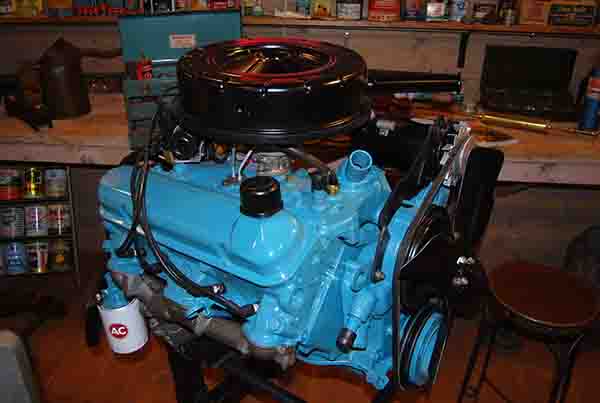
From 1990 to 1998, the only Pontiac offered with a V8 was the Firebird. The options got pretty hot with up to 325 hp available in some models in certain years. Only 5.7-liter V8s were offered. In 1998, the motor was changed from the 350-cid LT1 to the 346-cid LS1.
The Pontiac GTO was relaunched in the United States in late 2003, based on the Holden (GM’s Australian branch) Monaro’s Omega-derived platform. The revival was prompted by former GM chairman Bob Lutz, who drove a Holden Monaro while on a business trip in Australia. The GTO was produced in the suburb of Elizabeth South Australia, and was equipped with the Chevrolet Corvette’s LS1 V8 engine with a choice of a six-speed manual transmission or a four-speed automatic.
Pontiac gained a new V8 powered muscle car for 2009 in the form of the G8 GXP sourced from Holden. The 2009 Pontiac G8 GXP sport sedan was powered by a 6.2-liter V8 LS3 engine that produced 402 hp. Offered with a six-speed manual or six-speed automatic transmission, 0 to 60-mile per hour acceleration for the G8 GXP was in the mid-four seconds.
Sadly for fans, the Pontiac brand couldn’t survive GM’s cost-cutting measures and in 2010, the brand was discontinued. Still, the passion for Ponchos remains.

